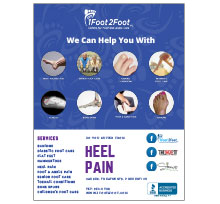Table of Contents
Heel Pain - Introduction
Have you been experiencing pain in your heels? It can be a dull ache or a sharp pain that comes and goes. If you experience heel pain regularly, it is worth getting evaluated by a podiatrist. Your podiatrist can help you determine the cause of your heel pain as well as help you to establish a treatment plan that works for your specific needs.
Many conditions can cause heel pain symptoms and below we will take a look at some of the common ones.
Plantar Fasciitis
One of the most common conditions is plantar fasciitis. This is inflammation of the plantar fascia, the ligament that runs from the heel bone to the tip of the foot. This pain is often felt after long periods of rest and is typically on the underside of the foot, sometimes traveling to the middle of the foot.
Achilles Tendinitis
Achilles tendinitis is an overuse injury of the tendon that connects that calf to your heel bone. This injury is common in runners or athletes. Pain is usually located above the heel and in the back of the leg and may be more severe after long periods of rest. While many cases of Achilles tendinitis can be treated at home, there is a risk of the tendon weakening over time and eventually tearing. This is very painful and requires surgical repair.







